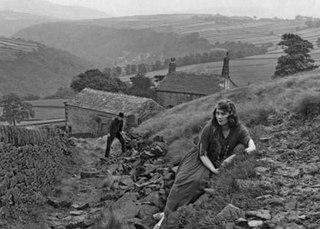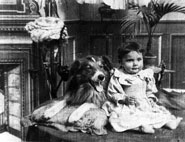The year 1908 in film involved some significant events.
The year 1905 in film involved some significant events.
The year 1904 in film involved some significant events.

Mother India is a 1957 Indian epic drama film, directed by Mehboob Khan and starring Nargis, Sunil Dutt, Rajendra Kumar and Raaj Kumar. A remake of Khan's earlier film Aurat (1940), it is the story of a poverty-stricken village woman named Radha (Nargis), who in the absence of her husband, struggles to raise her sons and survive against a cunning money-lender amidst many troubles.

Linda Denise Blair is an American actress and activist. Known for her work in the horror genre, she first came to prominence with her portrayal of Regan MacNeil in The Exorcist (1973), for which she won a Golden Globe Award and received a nomination for the Academy Award for Best Supporting Actress. The film established her as a scream queen and she reprised her role in two sequels: Exorcist II: The Heretic (1977) and The Exorcist: Believer (2023).

Cecil Milton Hepworth was a British film director, producer and screenwriter. He was among the founders of the British film industry and continued making films into the 1920s at his Hepworth Studios. In 1923 his company Hepworth Picture Plays went into receivership.

Alice in Wonderland is a 1903 British silent fantasy film directed by Cecil Hepworth and Percy Stow. Only one copy of the original film is known to exist. The British Film Institute (BFI) partially restored the movie and its original film tinting and released it in 2010. According to BFI, the original film ran about 12 minutes; the restoration runs 9 minutes and 35 seconds. At the beginning of the restoration, it states that this is the first movie adaptation of Lewis Carroll's 1865 children's book Alice's Adventures in Wonderland. It was filmed mostly at Port Meadow in Oxford.

Way Down East is a 1920 American silent romantic drama film directed by D. W. Griffith and starring Lillian Gish. It is one of four film adaptations of the melodramatic 19th century play of the same name by Lottie Blair Parker. There were two earlier silent versions and one sound version in 1935 starring Henry Fonda. Griffith's version is particularly remembered for its climax in which Gish's character is rescued from doom on an icy river.
Walton Studios, previously named Hepworth Studios and Nettlefold Studios, was a film production studio in Walton-on-Thames in Surrey, England. Hepworth was a pioneering studio in the early 20th century and released the first film adaptation of Alice's Adventures in Wonderland.
Supernatural horror film is a film genre that combines aspects of supernatural film and horror film. Supernatural occurrences in such films often include ghosts and demons, and many supernatural horror films have elements of religion. Common themes in the genre are the afterlife, the Devil, and demonic possession. Not all supernatural horror films focus on religion, and they can have "more vivid and gruesome violence".

May Clark was an English silent film actress turned cinematographer. She played Alice in the 1903 film Alice in Wonderland, the first film adaptation of Lewis Carroll's 1865 children's book Alice's Adventures in Wonderland.

Helen of Four Gates is a 1920 British silent melodrama film directed by cinema pioneer Cecil Hepworth and starring Alma Taylor, James Carew, and Gerald Ames.
Baby's Toilet is a 1905 British short film directed by Cecil Hepworth. The film features Hepworth's baby daughter Elizabeth being bathed and dressed by her nurse, and was categorised by Hepworth as a "Domestic Scene". In the film Hepworth combines a series of shots to produce a narrative depicting the bathing process from beginning to end. He would later acknowledge the influence of the pioneering work of the Lumière brothers on this and other similar films he produced in the 1900s. The print of Baby's Toilet survives, and Patrick Russell of the British Film Institute observes: "Long after Elizabeth Hepworth's own death, the affecting innocence of infancy remains a basic human theme. Baby's Toilet has lost none of its charm."
The Beggar's Deceit is a 1900 British short film directed by Cecil Hepworth. The film is a comedy sketch shot from a static camera position, with the composition divided into thirds: on the left the beggar, in the centre the pavement and pedestrians, and to the right the road and vehicle traffic.
How It Feels to Be Run Over is a one-minute British silent film, made in 1900, and directed by Cecil M. Hepworth. As in other instances of the very earliest films, the film presents the audience with the images of a shocking experience, without further narrative exposition.
Hepworth Picture Plays was a British film production company active during the silent era. Founded in 1897 by the cinema pioneer Cecil Hepworth, it was based at Walton Studios west of London.
Mohini Bhasmasur is a 1913 Indian mythological film directed by Dadasaheb Phalke and starring Kamlabai Gokhale and Durgabai Kamat. It is India's and Phalke's second full-length feature film. Mohini Bhasmasur is the first Indian film to have a female actor. In Raja Harischandra, India's and Phalke's first film, the role of the female was played by Anna Salunke, a male.
Lewin "Fitz" Fitzhamon was a British filmmaker, who worked as Cecil Hepworth's principal director in the early decades of the twentieth century. His best-known film is Rescued by Rover (1905). Other directing credits include An Englishman Trip to Paris from London (1904), That Fatal Sneeze (1907), The Man and his Bottle (1908) and A New Hat for Nothing (1910). In total, he directed around 400 films.

British horror cinema is a sub-category of horror films made by British studios. Horror films began in Britain with silent films in the early 20th century. Some of the most successful British horror films were made by Hammer Film Productions around the 1960s. A distinguishing feature of British horror cinema from its foundations in the 1910s until the end of Hammer's prolific output in the genre in the 1970s was storylines based on, or referring to, the gothic literature of the 19th century.







